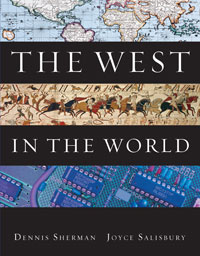 
The West in the World, 4th Edition (Sherman)Chapter 8:
Order RestoredChapter Summaries
In the High Middle Ages, people were organized into a social order in which everyone knew his or her place. These orders were arranged by function—laboring upon the land, praying, or fighting. There was little room in this social order for those who resided in towns and engaged in the increasingly important activities centered around trade. After the year 1000, advances in agricultural techniques led to an increase in population growth. Trade also quickened, and was accompanied by the growth of cities. The nobility constructed fortified houses across Europe and resisted the centralizing tendencies of kings. The prosperity of the age was accompanied by a flowering of intellectual life. The church also gathered strength and began to exert authority over secular matters. Resistance to this interference led to criticism of the church. The church responded by making some reforms and repressing its critics. The growing threat of the Muslim empire led to a call for the crusades by the church, and many Europeans traveled to faraway lands in defense of Christianity.
 |  |
|

















